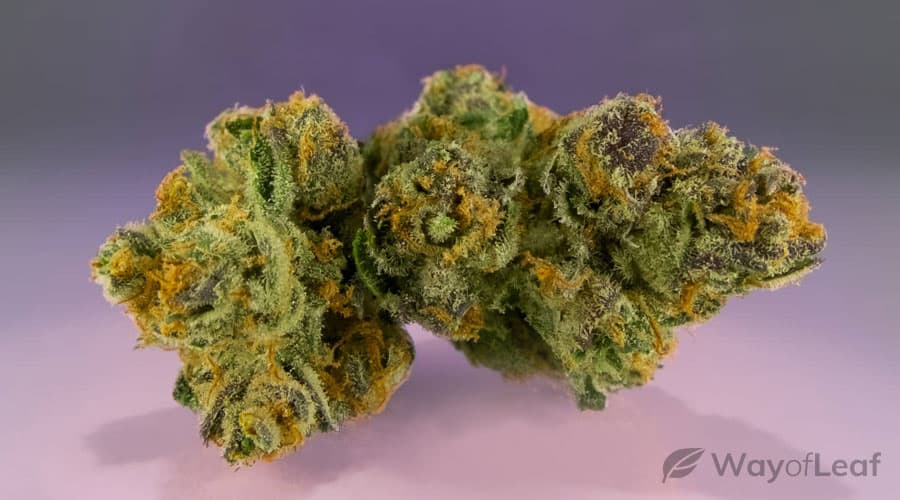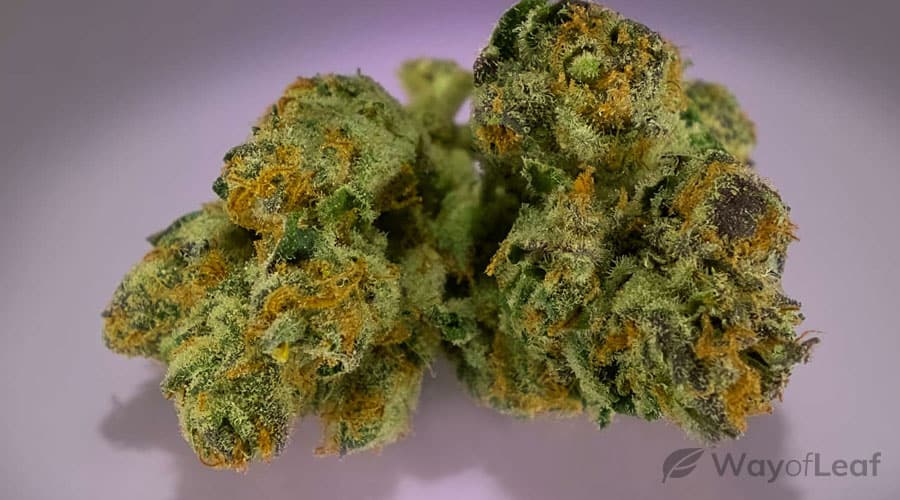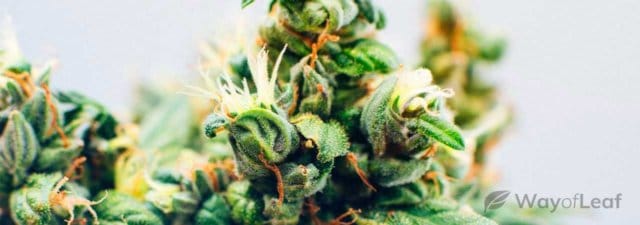If you have ever wanted to grow your favorite marijuana strain, we recommend checking out the full range of WayofLeaf growing guides. We have worked hard to find the best tips and tricks to help you enjoy potent crops with fat buds and resinous trichomes. In this growing guide for Granddaddy Purple, we show you how to get the best from a classic indica.
Want the fattest nugs and most potent trichomes for your Granddaddy Purple plants? Follow our step-by-step grow guide!
Also known as GDP, Granddaddy Purple was introduced to the world by Ken Estes in 2003. GDP is a cross of Big Bud and Purple Urkle and has become one of the most prized medical strains on the market. As well as winning the Green Cup in three consecutive years (2004 – 2006), GDP also received the coveted Inglewood Medical Cannabis Cup in 2004.
Grandaddy Purple is an indica-dominant (80%) hybrid and has a THC content of up to 23%. It certainly acts like a typical indica in so far as it provides you with a powerful cerebral high, followed by a feeling of intense relaxation. Once you have enjoyed the feeling of elation, you will feel relaxed and should be able to fall asleep.
Granddaddy Purple has a delightful grape and berry smell and taste. Given its effects, you won’t be surprised to discover that GDP is used to help with insomnia. It is also used in the medical community to help restore appetite and alleviate depression and anxiety. Keep reading to find eight great tips for growing GDP.
1 – GDP Prefers Indoor Growing
Granddaddy Purple’s indica genes mean It is short and bushy, which makes it the ideal strain to cultivate indoors. If you don’t train your GDP plants, they will grow into aesthetically pleasing shrubs up to three feet tall indoors, although they have been known to reach eight feet outdoors!

When grown indoors, GDP doesn’t mind if you use soil or prefer a hydroponics system. Its flowering time is eight weeks, although it can reach up to 11 weeks in some instances. It yields up to 19 ounces per square meter. If you elect to grow GDP outdoors, it grows into a dense bush capable of providing up to 17 ounces per plant. It is usually ready for harvest in mid-October.
2 – Super-Cropping Increases the Yield on Your Granddaddy Purple Grow
Before we continue, please note that Super Cropping is a High-Stress Training (HST) that could potentially go wrong. It involves hurting your Granddaddy Purple plants intentionally to ensure they grow bushier, with more buds and elevated THC levels. All of this is a marijuana plant’s natural response to protect itself in the wild if things go wrong.
HST involves ‘hurting’ your Granddaddy Purple plants intentionally to ensure they grow bushier, with more buds and elevated THC levels.
Although it carries risks, super cropping is renowned as an excellent technique because it works exceptionally well when performed correctly. As you know, THC is the much-loved compound in weed that produces its intoxicating effects. The flowers of the female plant produce the majority of your GDP’s THC.
Not everyone knows that marijuana plants create THC as a form of protection. In the wild, weed is susceptible to attacks from deer and various other creatures that try and eat the flowers. This is a disaster because it prevents the plants from creating seeds and reproducing. THC acts as a deterrent and keeps the plant safe.
If you want to super-crop your Granddaddy Purple plant, choose bendy branches and perform this HST technique during the vegetative stage. Squeeze and bend these branches in the direction you want them to grow. You will have to secure the stem (tie it down) to prevent it from returning to its original location. If you have cracked a branch, use duct tape to reinforce the plant so that it heals.
When you get it right, you benefit from more branches, more buds, a shorter and more controlled GDP plant, and a higher level of THC. Super cropping is excellent for experienced growers who want to grow weed in an enclosed space such as a closet.
3 – What’s the Right Temperature & Humidity Level for GDP Weed?
GDP prefers a dry climate, although it can handle slightly colder temperatures for a limited period when grown outdoors. As a rule of thumb, try to keep your Granddaddy Purple plants exposed to temperatures between 70 and 80 degrees Fahrenheit during the day. Don’t allow the night-time temperature to drop by more than 10–15 degrees.
PRO GROWING TIP: For optimal yields, try and keep your Granddaddy Purple plants exposed to temperatures between 70- and 80-degrees Fahrenheit during the day.
When growing Granddaddy Purple, moisture is the big enemy. If you’re intent on growing cannabis, you have to understand how humidity affects your plants. It is the amount of water vapor in the air and is expressed as a percentage. The higher the humidity, the fewer nutrients your weed can absorb. If it becomes too high, the plant’s stomata will close, which means it won’t absorb any water.
Too many growers believe that they must grow marijuana at high humidity levels of up to 80%. While this is true for specific strains, the majority of cannabis plants prefer it dialed down a notch. GDP is one such strain. When growing GDP, make sure the humidity level is at 50% or thereabouts. If you allow it to become too high, you risk bud rot and mildew.
DID YOU KNOW? If humidity levels get much higher than 50%, the stomata will close on your Granddaddy Purple plants, and it won’t be able to absorb water.
4 – Controlling Humidity on Your Granddaddy Purple Grow
Whether you’re growing indoors or outside, the first thing you should do is invest in a hygrometer. It is a device that measures humidity. Purchase a digital version (preferably one that also shows the temperature) and hang it in the room. As you would expect, the moisture in a room increases significantly when you water your plants. While this is great during the vegetative stage, it becomes a problem during flowering when you need humidity levels to drop.

A neat trick is to only water your plants when the lights are on because they will evaporate most of it during the day. If you water at night, the temperature falls, you don’t have to extract as much hot air, and humidity levels rise. Ideally, you will have a dehumidifier in place to combat excess humidity. Remember, humidity levels must fall during flowering. By the final few weeks, it should be no higher than 40%.
5 – Handling Bud Rot & Mildew
If you try to grow your GDP in a high-humidity environment, you leave it exposed to potential bud rot and mildew. Bud rot is a type of mold that infects the stems from the inside out. It isn’t easy to spot it early on, and if left untreated, it will produce spores that spread in all directions. The rot could infect your entire crop. Once your bud starts to mold, discard it immediately.
Bud rot is a type of moisture-induced mold that infects the stems inside the bud from the inside out.
Powdery mildew manifests itself on the buds and leaves of marijuana plants. You may find it on the lower branches initially because of a lack of sun exposure and increased humidity. It appears as a white, powdery substance and typically sits on the surface of the leaves. It spreads quickly and makes its way to bud sites.
You can prevent bud rot through pruning and training techniques. You improve the airflow and reduce the collection of moisture. Reduce root rot problems by properly watering your GDP plants and making sure they have breathable soil.
Powdery mildew is a lot easier to spot, and you can prevent it by pruning the plants and spraying them with organic fungicides. If your GDP plants develop this issue at harvest, mix a tiny amount of 3% hydrogen peroxide with water for a solution that removes the mildew by sterilizing the harvested plants.
6 – Feeding Your Granddaddy Purple Plants
As is the case with practically every marijuana plant, focus on nitrogen (N), phosphorus (P), and potassium (K). Keep nitrogen intake high during the vegetative stage and switch to a higher phosphorus solution during flowering. Essential secondary nutrients include copper, boron, iron, sulfur, manganese, magnesium, and calcium.
In terms of feeding, in general, go ‘organic’ when in doubt. Synthetic fertilizers can add far too much salt to the soil and impact your plants’ ability to absorb the nutrients. Your best bet is to purchase a pre-mixed bag of organic ‘super soil’, which should contain everything your GDP plants need.
Once you have chosen high-quality soil, the next step is to add the right amendments. In the vegetative stage, look for nitrogen-rich nutrients such as bat guano, crustacean meal, and worm castings. Organic add-ons that are high in phosphorus include rock dust, chicken manure, and bone meal. To boost your soil’s potassium content, add compost, wood ash, and kelp meal.
When your GDP plants are in the vegetative stage, look to add nitrogen-rich nutrients such as bat guano, crustacean meal, and worm castings.
After finding the right soil amendments, till your soil and begin digging, or else you can use a rototiller. The goal is to mix the earth correctly and ensure you reach all corners of your pots. When you mix everything, water the soil to cool any manure you have added.
7 – Attaining the Right pH Level in the Soil
It is important to remember that when you add nutrients to the earth, it increases or decreases the pH. The ideal pH range for GDP, as recommended by Ken Estes, is 6.0–6.2 in soil and 5.6–5.8 for hydroponics. The term pH determines the acid-alkaline balance in water or soil. The pH table ranges from 0 (battery acid) to 14 (liquid drain cleaner).
The ideal soil pH for Granddaddy Purple is 6.0-6.2, and 5.6-5.8 for hydroponics.
Pure water has a pH of 7.0 and is classified as ‘neutral’. Everything from 0 to 6.9 is acidic, and everything from 7.1 to 14.0 is alkaline. As you can tell from our recommendation, marijuana prefers slightly acidic soil. For the record, one full pH point is a tenfold increase or decrease. For example, at 5.0, coffee is ten times more acidic than milk, which has a pH of 6.0.
We recommend investing in a pH meter. When the soil pH is outside the right range, your GDP plants find it harder to reach the precious nutrients you provide them with. If your Granddaddy Purple has small, dark-green leaves and is growing slowly, the soil is probably at the wrong pH. Check by using runoff water.
There are unique solutions called pH UP and pH DOWN, which can adjust the soil. If you want a more organic solution, use soil sulfur to reduce the pH in alkaline soil and lime to decrease the acidity.
8 – When to Harvest GDP
As we mentioned above, Granddaddy Purple’s flowering time is usually eight weeks. Don’t panic if the plant doesn’t showcase its gorgeous purple hue during flowering. It is often only apparent after six weeks, and it provides a useful guide as to when you should consider harvesting. Once it turns entirely purple, it is only 1-2 weeks away from harvest.
If you are a first-time grower, it is difficult to determine the precise right moment to harvest. There are two ways to decide. Option A involves looking for the plant’s pistils to change color. The pistils are the sex organs of the female plant and are white during the majority of the growing cycle. However, towards the end, they start to turn red or brown. As is the case with most strains, GDP is at its most potent when 70–80% of the pistils have changed color.
Option B involves looking at the color of the trichomes, the tiny crystals that cover the leaves and buds of the plant. Your GDP plants are not ripe if they do not have clear trichomes. When your plants approach their harvest date, the trichomes begin to turn white. Once your plants have mainly red/brown pistils and white trichomes with a ‘mushroom’ head, they are harvest-ready. Although you can check pistil color with the naked eye, you will need to invest in a handheld microscope to use the trichome method.
Once your GDP weed plants have mainly red/brown pistils and white trichomes with a ‘mushroom’ head, they are primed for harvest.
![How to Grow Rainbow Colorful Cannabis [REVEALED]](https://wayofleaf.com/wp-content/uploads/2019/07/mj_how-to-grow-rainbow-colorful-cannabis_1920-1-640x225.jpg)
![What Is Marijuana Super Cropping? [Increase Yield and Potency]](https://wayofleaf.com/wp-content/uploads/2020/07/wol_what-is-marijuana-super-cropping_increase-your-yield-and-potency-640x225.jpg)



![How to Crossbreed Cannabis Plants? [Guide]](https://wayofleaf.com/wp-content/uploads/2019/01/mj_crossbreed-cannabis-plants_1920-640x225.jpg)
![The Many Colors of Weed [Complete Guide]](https://wayofleaf.com/wp-content/uploads/2018/12/mj_the-colors-of-cannabis-guide-640x225.jpg)

![How to Grow Super Silver Haze Weed [8 Tips]](https://wayofleaf.com/wp-content/uploads/2018/10/mj_tips-for-growing-super-silver-haze_1920-640x225.jpg)



